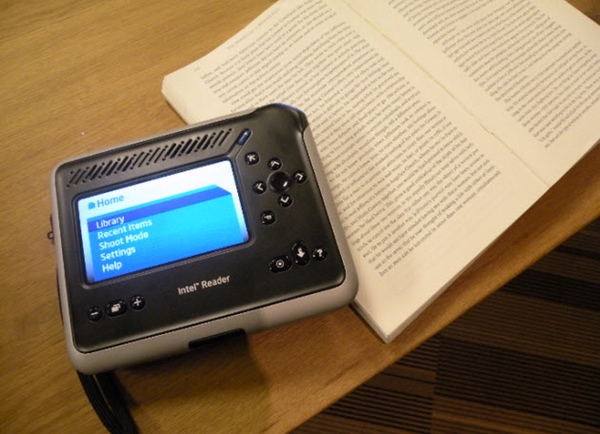
The Amazon Kindle costs $260. The Barnes and Noble Nook costs $260. The Sony reader is $300. Clearly there’s an established price point for what we call an e-book reader. Jumping into the e-book fray comes the Intel Reader, for fifteen hundred U.S. dollars. No WiFi, no associated book store, but it does include a 5 megapixel camera, and a host of features designed to make it the best choice for vision impaired people.
From the VentureBeat review:
The paperback-sized device is aimed at 55 million people in the U.S. who have eyesight problems and don’t want to be dependent on others for the pleasure of reading a novel, looking at a restaurant menu, or reading web site pages. It comes with a 5-megapixel digital camera that can be used to snap pictures of book pages. Foss said he was able to scan a 262-page book in a half hour and listen to the first chapter of the book while he was doing it. The device can read text in the DAISY format, plain text, as well as MP3 music files.
Can the Kindle or Nook help a vision-impaired individual order from the menu at a restaurant? I think not. The ability to scan and read custom text makes the Intel Reader something very different from the current offerings of e-book readers. This is clearly a multi-purpose device designed to enrich the life of its user, not just be a portal to selling electronic books. The Reader can speak the menus aloud to the user, and the instruction manual comes as an audio CD, making this extremely friendly to visually impaired individuals.
An optional book scanning system, the Intel Portable Capture Station, can be purchased, to allow home users to digitize books with ease. A lot of time and effort has gone into researching the ergonomics of the Reader and its accessories, since the target audience isn’t your normal fully-abled young-to-middle aged person.
The Intel Reader boasts some custom made parts, but is otherwise fairly run-of-the-mill in terms of capacity and performance:
The device has an Intel Atom microprocessor and two gigabytes of flash memory storage. It runs Linux software and some third-party software for scanning and reading aloud. With a fully charged battery, the device can read aloud for four hours. It can last for days on standby power. It can store about 500,000 pages of text or 600 pages of scanned book pages.
Here’s a video of the Intel Reader in action:
I think this is a terrific use of technology, and it demonstrates an impressive commitment from Intel in terms of research spending. I think this will create a lot of opportunities for the people who can afford to purchase it, and Intel deserves a lot of praise for cooking this thing up.
But I think that we, the general Internet population, can do a lot more. Listening to books read aloud by crappy digitized computer voices doesn’t really do justice to a lot of printed materials — especially novels. When I read a book, I hear in my mind’s ear distinct voices for each character. I read faster during tense or exciting scenes. I experience the story in a way that the monotonous drone of a computer voice can never reproduce.
Something like Project LibriVox can breathe real life into stories. We, the general Internet population, can donate a couple of hours of our leisure time to read a chapter — or a complete work — of a book so that others can enjoy the story in the dramatic manner in which it was intended. It’s a lot of work, I know: I recorded Thuvia, Maid of Mars by Edgar Rice Burroughs. But it’s also a lot of fun, and a very rewarding experience.